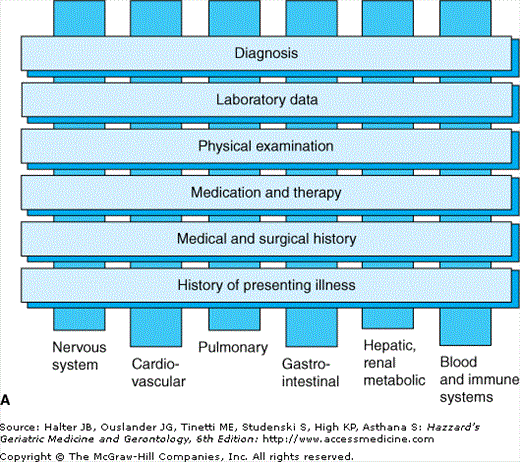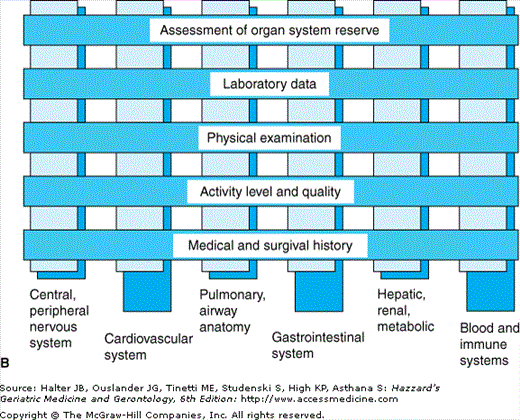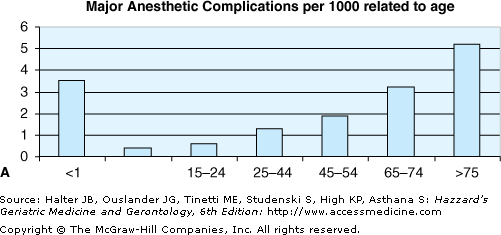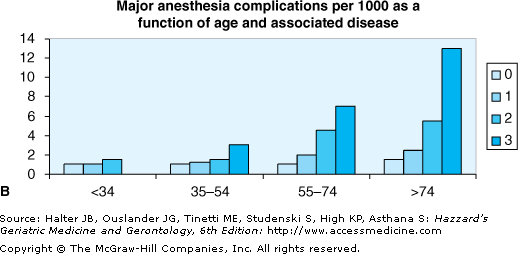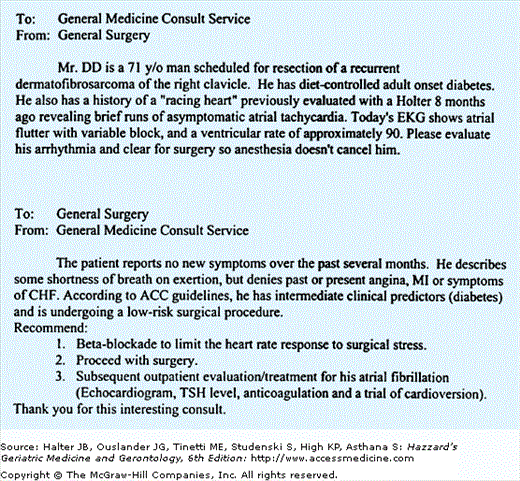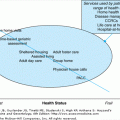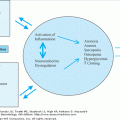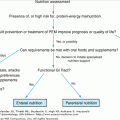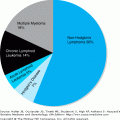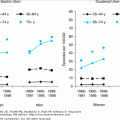Anesthesia: Introduction
Perioperative management of the older adult is complex. Anesthetic care itself is challenging, and both preoperative preparation and postoperative care for older adults assume greater importance than for young, healthy adults. Ideally, care is based on a comprehensive plan that integrates the roles of the anesthesiologist, surgeon, geriatrician, primary caregivers, and medical specialists. This chapter provides an overview of the role of the anesthesiologist and anesthesia techniques in pre-, peri-, and postoperative care of the older adult, in order to improve communication with other professionals who provide care to this vulnerable population.
Anesthesia and the Anesthesiologist
Anesthesia is the art and science of controlling physiologic processes in order to permit interventions on the body that would be intolerable owing to normal compensatory mechanisms. Surgery, which involves a direct assault on body tissues, is the standard paradigm for understanding anesthesia. Anesthesiologists perform other valuable services, including sedation for less invasive procedures, management of pain syndromes, and the provision of critical care. European anesthesiologists are also actively involved in emergency care. Anesthesia is based on an understanding of homeostatic mechanisms and their manipulation. Homeostenosis, the restricted range and capacity of homeostatic mechanisms associated with aging, provides a challenge to the anesthesiologist. In order to tailor appropriate anesthesia care for an older adult, the anesthesia team must be familiar with the effects of aging on multiple organ systems, particularly the heart, lungs, and brain, and must be familiar with physiologic changes of age, such as increase in body fat, decreased glomerular filtration, and reduced hepatic blood flow, which affect anesthetic drug action and duration.
Preoperative Care of the Older Surgical Patient
Preoperative care can take place in multiple settings and can occur briefly or over a period of time. The most important goal of preoperative assessment is not the risk assessment, but the improvement of the patient’s medical status prior to surgery and planning for the recovery process. The anesthesiologist provides care in a different time frame and uses a different approach than is typical for other specialties. The chief complaint usually takes the form of a request for anesthesia services for a specific operation. The anesthesiologist uses a vertical or systems-based approach, most clearly articulated by Stanley Muravchick (Figure 36-1). As part of this approach, the anesthesiologist assigns an American Society of Anesthesiologists physical status classification (Table 36-1). The American Society of Anesthesiologists score is a clinician’s tool, not a predictor of perioperative risk, because, while the American Society of Anesthesiologists score correlates broadly with outcomes, it does not incorporate age or type of operation, both significant influences on outcomes.
Figure 36-1.
A. The traditional medical approach to diagnosis can be represented schematically as a series of horizontal techniques of inquiry (open bars) applied across the various organ systems (shaded bars) to consolidate data describing the status of different organs into a unified diagnostic group. B. An organ-system-based “vertical” approach to preoperative assessment of the elderly patient by anesthesiologists differs from the traditional diagnostic approach because it applies the various technique of inquiry (shaded bars) sequentially in each major organ system (open bars) in order to assess organ function and functional reserve. The primary objective of preoperative assessment should be evaluation of physical status, rather than the identification of specific underlying disorders. (Used with permission from Muravchick S: Geroanesthesia. Principles for Management of the Elderly Patient. St. Louis, Mosby, 1997, page 17–18.)
P1 | A normal healthy patient |
P2 | A patient with mild systemic disease |
P3 | A patient with severe systemic disease |
P4 | A patient with severe systemic disease that is a constant threat to life |
P5 | A moribund patient who is not expected to survive without the operation |
P6 | A declared brain-dead patient whose organs are being removed for donor purposes |
In terms of ability to tolerate anesthesia and surgery, physiologic status is more important than chronological age. Aging is a highly variable process; young adults are more similar to each other physiologically than are older adults. While chronological age is insufficient to explain surgical outcomes, it has repeatedly been found to be associated with an increased risk of morbidity, mortality, and poor surgical outcomes. Age appears to be an important modifier of disease load, and the number of diseases (disease burden) appears to be the primary determinant of outcomes. Older adults with limited or low disease load have relatively lower risk of postoperative complications (Figure 36-2A), and the combination of high disease load and age is associated with extremely high rates of morbidity and mortality (Figure 36-2B). In addition, aging is not uniform across organ systems, and some organ systems may have aged or have been affected by disease more than others. Since aging is so heterogeneous, a careful preoperative evaluation is extremely important in preparing the older adult for surgery.
Figure 36-2.
(A) Major anesthetic complications per 1000 related to age. (B) Major anesthesia complications per 1000 as a function of age and associated disease. Legend indicates the number of diseases identified (0 = no disease, 3 = 3 or more diseases). Note that the disease burden significantly increases the likelihood of major complications as patients age.
How and when the preoperative evaluation occurs is highly variable. Many modern surgical practices admit patients for major surgery on the day of the operation. In this scenario, the anesthesiologist must perform the preoperative evaluation and discuss the perioperative experience and anesthetic options with the patient in a tight time frame. Alternative approaches include preoperative clinics and telephone calls, which can provide important opportunities to develop an understanding of the patient’s physical condition prior to the day of surgery.
The preoperative evaluation is an essential process in developing an anesthetic plan. Just as importantly, it provides an opportunity to answer questions for the patient and family. The most constructive of preoperative evaluations provide plans for minimizing risk in the perioperative period (i.e., before, during, and after surgery). As part of the evaluation, a general internist maybe consulted. Institutional policy and practices vary as to whether such input is required or even routine. A generalist’s statement that the patient has been “cleared for surgery” is of limited value. Much more useful to the anesthesiologist and surgeon is a complete overview of the patient’s medical condition, recent evaluations, and medications. The more the preoperative evaluator knows and understands, the less often the need for additional consultation. The best plan is based on good communication between the generalist and specialist physicians, the surgeon, the anesthesiologist, and the patient.
Preoperative management of significant medical problems should be determined. Medication regimens (such as anticoagulants, antidiabetic agents, and antiparkinsonian medications) require modifications and advance planning prior to surgery. Several members of the medical team can lead this effort, but the individual responsible should have a good understanding of the issues that need to be addressed and how they should be handled. Medication management protocols that have been jointly set by surgeons, anesthesiologists, and internists are often useful. When additional consultation is sought, the request should clearly define the issues that need to be addressed and the expected role of the consultant. The example shown in Figure 36-3 illustrates a reasonable delineation of the problem to be addressed. Anecdotally, an organized preoperative clinic can improve patient satisfaction and decrease the number of perioperative consults.
Risk assessment is a part of the preoperative process. Most of the time the objective of risk assessment is to decide how aggressive one should be in preparing the patient for surgery, rather than deciding that the surgical risk is too high. Risk assessment is most formalized in the form of the AHA/ACC guidelines for the evaluation of cardiac disease. The guidelines attempt to integrate severity of comorbid disease, exercise tolerance, and surgical severity into a rational plan, in order to determine who needs to enter an advanced evaluation process or to avoid diagnostic procedures with a risk greater than the proposed surgery itself. In fact, the AHA/ACC guidelines were originally developed specifically to limit the frequency of noninvasive cardiac testing, which has the potential to be used unnecessarily. It is important to remember that the AHA/ACC guidelines have never been formally tested, nor are they meant to supplant clinical judgment. Many medical problems in the older adult cannot be addressed using established guidelines so that decisions are based on clinical judgment. The impact on postoperative outcomes of optimizing medical conditions prior to surgery is usually unknown. Typical conditions that might be optimized preoperatively, even if not seriously unstable, include high blood pressure, diabetes, reactive airway disease, and coronary artery disease. One of the best examples of medical optimization leading to improved outcome is the use of beta-blockade for patients with known or suspected coronary heart disease.
Sometimes internists and anesthesiologists disagree on preoperative management, often about whether or not planned diagnostic tests can be delayed until after the surgery. The consult shown in Figure 36-3 provides an example. In this case, atrial flutter is not a contraindication to surgery. Why should its evaluation delay surgery? Some would argue that if the tests provide useful information or lead to an intervention that improves the patient’s status, then the patient will be better off having the tests done prior to elective surgery. In the example in Figure 36-3, an echocardiogram provides useful information, even if normal. If a test should be performed, it is reasonable to do it before surgery, unless surgical urgency dictates otherwise. Furthermore, if elective cardioversion is being considered, it should be done before surgery because heart rate control in the intra- and postoperative periods is more easily achieved when the patient is in sinus rhythm. As stated above, there is frequently little evidence upon which to base such judgment but coherent preoperative planning in an older adult can avoid confusion, surgical delay, and requests for emergent consultations that are rarely as complete as elective evaluations.
Geriatrician involvement improves perioperative care but is undervalued in most usual care settings. Comprehensive geriatric assessment (discussed in detail elsewhere) has a place in perioperative care because it is the best way to prevent geriatric-specific postoperative issues like delirium and pressure ulcers.
A unique part of the preoperative assessment of the older adult arises when a patient has a “do not resuscitate” order or other advanced care directives. Many patients have, in consultation with their primary-care physicians, elected to forgo resuscitative measures, because of fears that resuscitation will lead to poor outcome, or because they feel that resuscitation measures will be futile. These fears are supported by numerous studies that demonstrate that cardiac arrest in most settings carries a very poor prognosis, because arrests are usually unwitnessed and may be caused by advanced disease states. However, the operating room is a special setting in this regard. In contrast with other in-hospital cardiac arrests, cardiac arrests in the operating room carry a very favorable prognosis, because arrests are often because of reversible causes such as hemorrhage or drug effects, and because they are witnessed events where resuscitation is instituted within seconds. This means that, in the setting of surgery, a patient’s DNR order must be reconsidered in light of the different prognostic implications of cardiac arrest during surgery. Some organizations have standing policies that DNR orders are rescinded in the operating room. The DNR may be reinstituted either upon a physician’s order or automatically upon return to the ward. Regardless of the management plan, DNR orders require review and discussion with the patient. While the anesthesiologist should have such discussions with the patient, input from the patient’s other physicians can be invaluable.
Sometimes a primary-care physician or consultant offers advice on anesthetic management as a part of the anesthesia preoperative referral. These recommendations are usually not helpful. Requests to avoid hypotension and hypoxemia are so obvious as to be unnecessary. Surgical clearance limited to local or regional anesthesia can create problems. These restrictions may not be based on clear evidence. Regional techniques have limitations (see section on “Regional Anesthesia”). Regional anesthetic techniques occasionally fail in the operating room, requiring an immediate alternative. In some cases, local anesthesia may be feasible, but not preferable, as a result of patient characteristics such as apprehension or positioning issues, or because adequate anesthesia would be difficult to achieve with local approaches alone.
Anesthetic Methods and the Older Adult
Anesthesiologists have developed two major approaches to the provision of anesthesia. The first is general anesthesia, based on the systemic administration of medications whose principal effects occur in the central nervous system. The provision of various levels of sedation can be thought of as a subtype of general anesthesia. The second major approach is regional anesthesia, based on the use of one of a family of local anesthetics to block nerves. Spinal or epidural anesthesia applies these agents either in or around the spinal canal. Peripheral nerve blocks provide them around nerves subserving specific areas of the body. Local anesthetic agents injected into areas of skin to block the surrounding nerve endings can be thought of as a form of regional anesthesia. The two main forms of anesthesia are not mutually exclusive. A patient undergoing general anesthesia may have a peripheral nerve block to control postoperative pain, and a patient undergoing a procedure with spinal anesthesia is likely to receive hypnotic medications in concentrations that produce sedation. General anesthesia and regional anesthesia work via different mechanisms, so their effects in the older adults are discussed separately below.
This section will review the goals of general anesthesia, principles of intraoperative care, types of anesthetic agents, and age-related special management issues. While unconsciousness is the most apparent distinguishing feature of general anesthesia, it has many other important effects. The cardinal features of general anesthesia are (1) lack of consciousness, including amnesia for events that occur under anesthesia, (2) analgesia or absence of pain, (3) lack of movement in response to painful stimuli, and (4) control of the reflex responses to painful stimuli. In the early years of anesthesiology, ether was found to provide all of these properties, although it did cause prolific vomiting following emergence and had a tendency to cause explosions in the operating theater. The observation that ether, a relatively simple molecule, produced an adequate anesthetic state, along with compelling physicochemical evidence suggesting that potency was linked to the length of the carbon chain of the anesthetic, led anesthesiologists to search for a single mechanism or receptor that was responsible for anesthesia. In subsequent years, it has become clear that anesthesia does not result from alterations of a single receptor, but that all available drugs with anesthetic properties have specific targets. General anesthesia results from alterations at multiple receptors and multiple drugs are almost always used to produce general anesthesia.
Standard procedure for anesthetic care is to monitor the electrocardiogram, blood pressure, and oxygen saturation. When general anesthesia is undertaken, end-tidal carbon dioxide monitoring is required and temperature should be monitored for most procedures. Intravenous access with large-bore (18 gauge or larger for major surgery) catheters inserted into peripheral veins is almost universally required as part of anesthetic care. The induction of anesthesia is generally accomplished with intravenously administered hypnotic agents. The appropriate dosages of these agents are all decreased with aging. Maintenance of a patent airway and adequate ventilation are primary goals, usually attained via an endotracheal tube and positive pressure ventilation. In recent years, anesthesiologists have developed a variety of new airway devices, such as the laryngeal mask airway, as alternatives to endotracheal intubation. The choice of device and backup procedures varies with procedure and practitioner. Spontaneous breathing is also a feasible and potentially desirable alternative to positive pressure ventilation.
Adjustment of the depth of anesthesia consumes a good deal of the anesthetic manipulations during surgery. How “deep” or “light” the patient is at any moment depends on the balance of drug effects and the surgical stimulus. Titration of the depth of anesthesia is typically a matter of balancing the tendency of the surgical stimulus to activate the brain and stimulate the sympathetic nervous system against the anesthetic’s ability to depress brain activity and limit the stimulation of the sympathetic nervous system. Thus, a patient might be fully anesthetized one moment and then be inadequately anesthetized a moment later if the surgical (painful) stimulus suddenly increases. The effective depth of anesthesia can be monitored through a variety of methods. The primary approach for years has been to monitor blood pressure and heart rate. Hemodynamic signs of light anesthesia generally appear long before a patient has any chance of “waking up” or of having postoperative recall. A rise in blood pressure and/or heart rate is typically the first sign of light anesthesia and triggers an increase in the concentration of volatile gas (currently isoflurane, sevoflurane, or desflurane) concentration or administration of a small bolus of a fast-acting opioid such as fentanyl. A safe strategy is to keep blood pressure at or slightly lower than the patient’s usual baseline, although this can be quite difficult to accomplish in older patients. The risk of awareness/recall is relatively remote under such circumstances.
Since depth of anesthesia is such a critical issue in perioperative care, and because it can change moment to moment, anesthesiologists have attempted for years to use electroencephalograms to define a brain-based measure of depth of anesthesia. Recently, devices have been developed that use advanced signal processing and computer miniaturization to provide a single number between 0 and 100 that indicates depth of anesthesia. When these devices have been applied to older adults, the findings suggest that the amount of anesthetic typically used to control blood pressure and heart rate frequently results in extremely deep anesthesia for the brain. Excessive depth of anesthesia has been proposed to contribute to poor outcomes. This important area requires further study and might be valuable in the clinical arena in the future.
Patient movement in response to a surgical stimulus, even if very slight, suggests an inadequate depth of anesthesia. Too light anesthesia can result in patient awareness and failure of amnesia. The amount of movement is usually subtle. Most slight movement does not imply such a light level of anesthesia as to result in awareness or recall. Movement cannot be used as an indicator of depth of anesthesia if a patient is paralyzed by neuromuscular blocking agents and common adjuvants for abdominal surgical cases or in cases where even minimal movement is surgically unacceptable. Unintentional excessively light anesthesia is most likely to occur when neuromuscular blocking agents produce muscle relaxation in the presence of lighter general anesthetic agents, such as nitrous oxide and opioids, with little or no potent gases. The electroencephalogram monitors described above have an unclear role in preventing awareness during surgery.
The pharmacokinetics and pharmacodynamics of the intravenous and volatile anesthetic agents are altered in the older adult, so that administration must be adjusted. A general rule of the thumb is that all drugs will have more dramatic and longer-lasting effects in older patients, although this is not universally true. The mechanisms vary with the drug but include changes in protein binding, decreases in initial volume of distribution, alterations in receptor sensitivity, and slowed renal or hepatic metabolism. The therapeutic effect of many intravenous anesthetic agents is not dissipated by metabolism, but by redistribution of the drug from the brain to the fat. These drugs are highly lipid soluble and cross membranes rapidly. On initial injection, the blood levels are very high but will fall as the drug is taken up into fat. The high initial blood levels will promote rapid transfer of the drug into highly perfused organs such as the brain. Even though fat serves as an almost limitless sink for lipid-soluble drugs, blood flow to fat is low and transfer of drug into fat takes time. Transfer time largely dictates the duration of a drug’s clinical effect. As blood levels decrease, drug returns to the blood from the more vascular organs and is then transferred to the fat, dissipating the therapeutic effect. Substantial and/or prolonged administration of many drugs results in drug levels in fat that become high enough to sustain a (residual) blood level that has a therapeutic effect. From an anesthetic management viewpoint, the pharmacokinetic and pharmacodynamic changes of aging rarely present a major problem. Patient response to drugs is variable at any age, so, with the exception of induction, drugs are given in small doses and titrated to effect. The trend today in anesthesia practice is to use drugs that are short acting. These drugs either have shorter metabolic half-lives or redistribute to yield very low blood levels with minimal residual effects, or do both. For example, propofol and thiopental are equally effective induction agents and both are “short-acting” because these redistribute rapidly into fat. The residual blood levels of propofol, however, produce less residual sedation than occurs with thiopental, and propofol also has a shorter metabolic half-life. These principles of drug pharmacokinetics apply to patients of all ages, but the ability to use drugs with rapid fat uptake, but minimal residual effects, is particularly helpful in older patients.
Hemodynamic stability is a core goal of anesthesia and one of the more challenging aspects of anesthetic care of the older adult. Many characteristics of aging contribute to the increased vulnerability of older adults to hemodynamic instability (Table 36-2). General anesthesia lowers the blood pressure in everyone. This effect is owing to decreased sympathetic tone, which, in turn, may lower heart rate, decrease systemic vascular resistance, and cause peripheral pooling of blood, which will lower cardiac preload. There is also some direct myocardial depression. These effects are exaggerated in older adults. Sympathetic nervous system activity commonly increases with age and so may be more reactive to stimuli than in young people. Chronic hypertension, common in older patients, further exaggerates the vascular response to changes in sympathetic nervous system activity. In particular, the aorta stiffens with age and typically results in left ventricular hypertrophy. Hypertrophy leads to a reduction in the rate of diastolic relaxation, which, in turn, diminishes early diastolic filling. Adequate ventricular preload becomes dependent on passive filling related to left atrial pressure and active filling related to atrial contraction. Both mechanisms must overcome the increased ventricular stiffness and both require a full atrium. Yet atrial blood volume is difficult to keep constant. Veins also stiffen with age. Venous stiffness reduces the capacity to buffer changes in blood volume, making atrial filling more sensitive to overall volume status as well as to the effects of the sympathetic nervous system on blood distribution. In consequence, older patients are more prone than young patients to both hypotension and hypertension during surgery.
AGING-INDUCED CARDIOVASCULAR CHANGE | PHYSIOLOGICAL CONSEQUENCE | ANESTHETIC AND PERIOPERATIVE IMPLICATION |
|---|---|---|
Loss of sinoatrial node cells and conduction system fibrosis | First-degree block and occasional sick sinus syndrome | Severe bradycardia when coupled with potent opioids |
Stiff arteries | Systolic hypertension Impedance mismatching at end ejection, leading to myocardial hypertrophy and impaired diastolic relaxation | Labile blood pressure Diastolic dysfunction and sensitivity to volume status |
Myocardial hypertrophy and connective tissue stiffening | Increased ventricular stiffness Ventricular filling dependent on a well-maintained atrial pressure |
